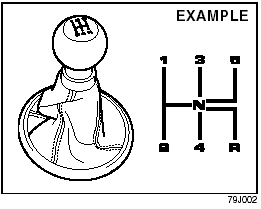Using the Transaxle

4-Speed Automatic Transaxle

Gearshift lever

WARNING:
Always depress the brake pedal
before shifting from “P” (Park) (or
“N” (Neutral) if the vehicle is stationary)
to a forward or reverse gear, to
help prevent the vehicle from moving
unexpectedly when you shift.
Use the gearshift lever positions as described below:
P (Park)
Use this position to lock the transaxle when the vehicle is parked or when starting the engine. Shift into Park only when the vehicle is completely stationary.
R (Reverse)
Use this position to reverse the vehicle from stop. Make sure that vehicle is completely stationary before shifting into Reverse.
N (Neutral)
Use this position for starting the engine if the engine stalls and you need to restart it while the vehicle is moving. You may also shift into Neutral and depress the brake pedal to hold the vehicle stationary during idling.
D (Drive)
Use this position for all normal driving.
With the gearshift lever in “D” range you can get an automatic downshift by pressing the accelerator pedal. The higher the vehicle speed is, the more you need to press the accelerator pedal to get a downshift.
3 (Low 3)
Use this position for driving on moderate uphill and downhill gradients. The engine braking effect on moderate downhills can be used in this position. The transaxle shifts up only to 3rd gear.
2 (Low 2)
Use this position to provide extra power when climbing hills, or to provide engine braking when going down hills.
L (Low 1)
Use this position to provide maximum power when climbing steep hills or driving through deep snow or mud, or to provide maximum engine braking when going down steep hills.
NOTE:
If you move the gearshift lever to a lower
gear while driving faster than the maximum
allowable speed for the lower gear, the
transaxle will not actually downshift until
your speed drops below the maximum
speed for the lower gear.
CAUTION:
Be sure to take the following precautions
to help avoid damage to the
automatic transaxle:
• Make sure that the vehicle is completely
stationary before shifting
into “P” or “R”.
• Do not shift from “P” or “N” to “R”, “D”, “3”, “2”, or “L” when the engine is running above idle speed.
• Do not rev the engine with the transaxle in a drive position (“R”, “D”, “3”, “2”, or “L”) and the front wheels not moving.
• Do not use the accelerator to hold the vehicle on a hill. Use the vehicle’s brakes.

Manual Transaxle
Starting off
To start off, depress the clutch pedal all the way to the floor and shift into 1st gear.
After releasing the parking brake, gradually release the clutch. When you hear a change in the engine’s sound, slowly press the accelerator while continuing to gradually release the clutch.
Shifting
All forward gears are synchronized, which provides for quiet, and easy shifting.
Always depress the clutch pedal all the way to the floor before shifting gears. Keep the engine speed does not rise into the red zone of the tachometer.

WARNING:
• Reduce your speed and downshift
to a lower gear before going down
a long or steep hill. Downshifting
will allow the engine to provide
braking. Avoid riding the brakes or
they may overheat, resulting in
brake failure.
• When driving on slippery roads, be sure to slow down before downshifting.
Large and sudden
changes in engine speed may
cause loss of traction, which could
cause you to lose control.
• Make sure that the vehicle is completely stopped before you shift into reverse.
CAUTION:
• To help avoid clutch damage, do
not use the clutch pedal as a footrest
while driving or use the clutch
to keep the vehicle stationary on a
slope. Depress the clutch fully
when shifting.
• When shifting or starting off, do not race the engine. Racing the engine can shorten engine life and affect smooth shifting.
See also:
Engine Hood
To open the engine hood:
1) Pull the hood release handle located on
the outboard side of the driver’s side of
the instrument panel. This will disengage
the engine hood lock half-way.
2) Pus ...
Suzuki SX4 in the Market
If my experience driving around Chicago is any indicator, there's quite a
market for small, sporty-looking hatchbacks. Most of them are heavily modified
used cars, and against this benchmark the S ...
Windows
Power Window Controls
Driver’s side
The power windows can only be operated
when the ignition switch is in the “ON” position.
The driver’s door has switches (1), (2), (4),
(5), to operat ...
